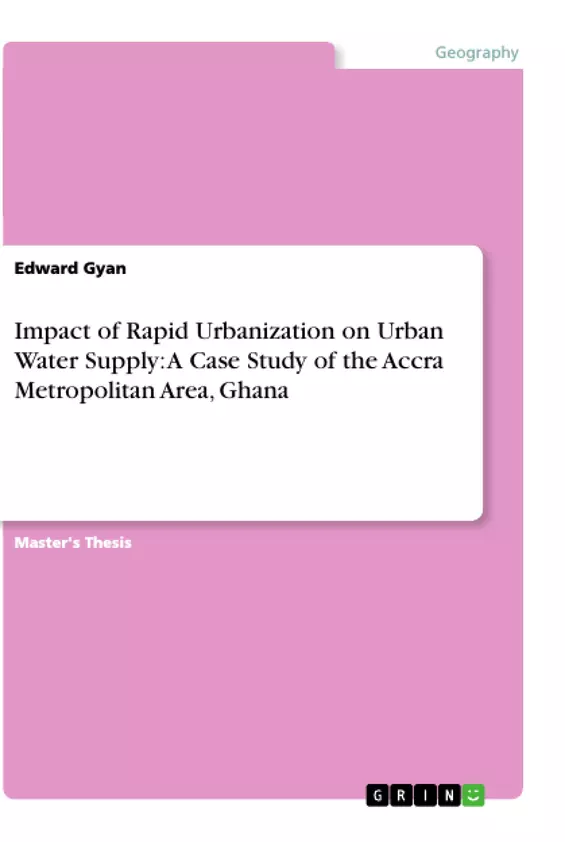The vital role played by urbanization in a country’s development cannot be overemphasized. Urbanization ensures cost-effectiveness in the provision of public infrastructure such as water, electricity, roads, healthcare and schools among others in urban areas as a result of the spatial clustering of population and economic activities. Nonetheless, rapid urbanization without corresponding infrastructure provision results in congestion and pressure on existing facilities and presents a plethora of challenges to city managers and utility providers. This study therefore seeks to examine the major impacts of rapid urbanization on urban water supply. To do this, a case study approach was adopted in order to put the study into context and perspective. More specifically, the study takes the city of Accra, Ghana’s rapidly growing economic and political centre, as an empirical case. The study was based on empirical research conducted in selected suburbs within the city of Accra, including a series of structured and semi-structured in-depth interviews with households, representatives of the Accra Metropolitan Assembly (AMA) and the officials of Ghana Water Company Limited (GWCL). Additionally, the assessment of literature, websites and official city and state policy documents played a crucial role.
The broad assessment of the abundant literature consulted and the field survey point to the fact that, indeed, the rapid rate of urbanization in Accra has serious impacts on urban water supply including the environment, physical water infrastructure and overall service delivery. Frequent bursts of pipe lines due to unplanned developments, high incidence of water theft, frequent service interruption due to high water demand and undermined water quality as a result of poor sanitation management are some of the major impacts. Based on the key findings the study proposes relevant policy measures that could help alleviate the negative impacts. These include the need to promote decentralized development in the country; effective planning, regulation and control of development; rehabilitation and expansion of existing water infrastructure in the city; and monitoring and clamping down on water theft in the city among others. The overarching goal of this study is to provide valuable insights into the formulation and implementation of holistic urban policy on water infrastructure towards sustainability and realisation of urban efficiency.
Inhaltsverzeichnis
- Zusammenfassung
- Einleitung
- Literaturübersicht
- Methoden
- Ergebnisse und Diskussion
- Schlussfolgerungen und Empfehlungen
- Literaturverzeichnis
Zielsetzung und Themenschwerpunkte
This thesis examines the impact of rapid urbanization on urban water supply, focusing specifically on the Accra Metropolitan Area in Ghana. Through a case study approach, the research aims to analyze the challenges and consequences of urbanization on water infrastructure and service delivery in Accra.
- The impact of rapid urbanization on urban water supply
- Challenges and opportunities for managing water resources in urbanizing areas
- The role of infrastructure development and planning in ensuring sustainable water supply
- The influence of urban growth on water quality and distribution
- Policy recommendations for mitigating the negative effects of urbanization on water supply
Zusammenfassung der Kapitel
- Zusammenfassung: Provides a concise overview of the thesis, highlighting the research problem, methodology, key findings, and policy recommendations.
- Einleitung: Introduces the research topic, the context of urbanization in Accra, and the motivation for the study. It outlines the research questions and objectives.
- Literaturübersicht: Reviews existing literature on the impact of urbanization on water supply, focusing on relevant studies and theoretical frameworks.
- Methoden: Describes the research methodology, including the case study approach, data collection techniques, and data analysis methods used in the study.
- Ergebnisse und Diskussion: Presents and analyzes the findings of the research, discussing the impact of urbanization on water supply in Accra. It examines the challenges, opportunities, and potential solutions identified through the study.
Schlüsselwörter
Urbanization, rapid urbanization, population growth, infrastructure, urban water supply, Accra, Ghana, water resources management, sustainable development, policy recommendations, water scarcity, water quality, infrastructure development, water security.
- Citation du texte
- Edward Gyan (Auteur), 2016, Impact of Rapid Urbanization on Urban Water Supply: A Case Study of the Accra Metropolitan Area, Ghana, Munich, GRIN Verlag, https://www.grin.com/document/932843



